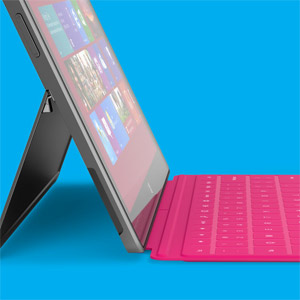 NEWS
NEWS
 NEWS
NEWS
 NEWS
NEWS
![]() The mystery Microsoft tablet Surface is out and it has nothing to do with the Xbox—not a disappointment to anyone, although the mystery still continues across some elements of the tablet’s technology. Looking at other developments across Microsoft’s technology line, it’s about time we start speculating about how the software giant intends to differentiate themselves from major competitors in the scene such as Apple and Google.
The mystery Microsoft tablet Surface is out and it has nothing to do with the Xbox—not a disappointment to anyone, although the mystery still continues across some elements of the tablet’s technology. Looking at other developments across Microsoft’s technology line, it’s about time we start speculating about how the software giant intends to differentiate themselves from major competitors in the scene such as Apple and Google.
Tablet technology represents an almost-bridge between small mobile devices and on-desk PCs, and with the advent of Microsoft’s SmartGlass, it can also represent another connection in the entertainment cloud. It will fit nicely into a family of products all of which act and react similarly and are capable of moving user interface between them seamlessly as a consumer moves between different modes of life.
The Microsoft Surface exists in two different models, which we know now are also different hardware, but act basically the same. It also supports something that few tablets currently do: an on-table keyboard. Most tablets are marketed to the public as a stand-alone device that’s basically an overgrown smartphone where the multitouch screen is the most important input. Certainly peripherals exist to allow tablets to have keyboards; but they’re generally an afterthought.
Gesture-support Would Separate Surface from the Flock
Keyboards and multitouch are nice for tablets, but the keyboard itself will take the hands away from the screen. For the standard PC this is resolved with a pointing device such as a mouse or a mousepad. Microsoft could use what they’ve learned from Kinect to resolve this problem when it comes to a tablet plus keyboard by being able to watch the person’s hands. As we know, the Surface has at least one camera facing the user (not quite as good as a full Kinect setup that can readily detect depth, but there could be a peripheral to resolve that) and that could be used to provide gesture-detection support.
Typing on a keyboard is only one element of how people interact with technology but people also interact with objects via gesture and introducing the ability to detection motion away from the keyboard would make this product even more useful than any product on the market. Doing a Google search rapidly with the keyboard and then scrolling down by just lifting one hand from the keyboard and slowly moving pinched fingers down (without having to reach down to the tablet) would give it an ability we haven’t seen yet.
Kinect can already do this.
SmartGlass and virtualizing the entertainment experience as well as work experience
The personal cloud has become something that tablets do well, except that by and large it’s been swallowed up into the device itself. The Kindle Fire may be capable of storing documents in the cloud and archiving them on Amazon’s servers, and they’re accessible via a PC; but it’s connected entirely to the Fire and doesn’t spread out well to other mobile devices. We see the same issue with iPads, although the presence of the iPhone being able to use apps that spread cloudy archived documents between smartphone and PC does help relieve this.
The next step is fully virtualizing the UI state and workspace of the user—but we’re not quite there yet—instead Microsoft appears to be leaping into SmartGlass with the expectation that people may be absorbing media in a multitude of forms and any device running a Microsoft OS can become a window into that media-experience.
Each SmartGlass enabled device becomes a window into the current media experience be it a YouTube video, TV show, a movie, or even an audio playlist. A Microsoft family of devices adding in a tablet like the Surface could use this technology to enable a person to continue a documentary (or a training video) that they were watching on their PC or TV as they move around the house—for example, they might be watching a training video about how to fix a leaky faucet and want the instructions with them while they’re fixing it. (Leaving aside potentially killing their tablet with water spray.)
Alternatively, a person could be commuting with their smartphone and in a conversation with their office about a project or products and have data passed to them. They could view the data on their smartphone, but tiny screens and little keyboards aren’t always the best-possible-UI for interacting with certain data. As a result, they could use the SmartGlass technology concept to enable them to pull out their Surface tablet, set it up on a nearby table, and then move their interface space from the mobile phone onto the Surface.
By becoming part of a family of products designed to work together, via OS, technology, or finely-tuned apps, Microsoft could make the Surface a very effective bridge between different business and life needs that each of these devices is fit to mold.
This collective family element could also drive more customers to go all Microsoft-kit for their equipment and would serve to give the software giant a working edge not just against other tablet manufacturers; but also mobile, and PC—a business model already well-trod by Apple and one that’s being slowly invaded by Google Android.
THANK YOU